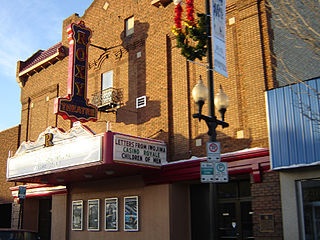
Saskatoon Fairview is a provincial electoral district for the Legislative Assembly of Saskatchewan, Canada. The district includes the neighbourhoods of Kensington, Parkridge, Pacific Heights, Blairmore S. C., Confederation Park and part of Massey Place. Contrary to the name, the neighbourhood of Fairhaven is not part of the riding.
The Saskatchewan Railway Museum is a railway museum located west of Saskatoon, Saskatchewan at the intersection of the Pike Lake Highway and the Canadian National Railway tracks. It is operated by the Saskatchewan Railroad Historical Association (SRHA) and was opened 1990.
Innovation Place is the registered business name of the Saskatchewan Opportunities Corporation (SOCO), a crown corporation in Saskatchewan. SOCO operates two research parks: one located near the University of Saskatchewan in Saskatoon, Saskatchewan, and the second near the University of Regina in Regina, Saskatchewan. In 2018, approximately 140 companies were based at Innovation Place. Research parks such as Innovation Place are sometimes referred to as science parks or technology parks.
Floral, Saskatchewan is an unincorporated community in the province of Saskatchewan, Canada.

Nutana is a primarily residential neighbourhood located near the centre of Saskatoon, Saskatchewan, Canada. It includes the business district of Broadway Avenue. It comprises a nearly even mixture of low-density, single detached dwellings and apartment-style multiple unit dwellings. As of 2009, the area is home to 6,261 residents. The neighbourhood is considered a middle to upper-income area, with an average family income of $67,657, an average dwelling value of $206,830 and a home ownership rate of 51.3%. According to MLS data, the average sale price of a home as of 2013 was $409,891. First established in 1883, Nutana was the original settlement of what now makes up the city of Saskatoon.
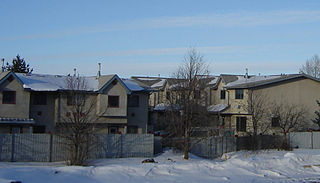
Confederation Suburban Centre is a community in the city of Saskatoon, Saskatchewan, which consists primarily of commercial development.

Eastview is a mostly residential neighbourhood located in south-central Saskatoon, Saskatchewan, Canada. It is a suburban subdivision, consisting of low-density, single detached dwellings, low-rise apartment buildings and semi-detached houses. As of 2007, the area is home to 3,566 residents. The neighbourhood is considered a middle-income area, with an average family income of $58,703, an average dwelling value of $260,050 and a home ownership rate of 51.6%. According to MLS data, the average sale price of a home as of 2013 was $318,449.
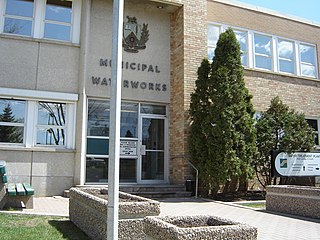
King George is an older inner city neighbourhood located near the centre of Saskatoon, Saskatchewan, Canada. It consists mostly of low-density, single detached dwellings. As of 2011, the area is home to 1,902 residents. The neighbourhood is considered a lower-income area with an average family income of $47,581, an average dwelling value of $146,941 and a home ownership rate of 69.1%. According to MLS data, the average sale price of a home as of 2013 was $198,822.

The Exhibition subdivision of Saskatoon, Saskatchewan, Canada, is located on the banks of the South Saskatchewan River and was developed between the two major World Wars. To the west is the Diefenbaker Management Area which boasts the Diefenbaker park and Pioneer Cemetery. The park includes a medium-sized hill which is used for tobogganing and snowboarding, and the park itself is a frequently-used venue for picnics and public events and performances. The Exhibition community is also known as Thornton, after a (now-demolished) public elementary school that formerly served the area and early in its history also went by the name Bellevue.
The history of Saskatoon began with the first permanent settlement of Saskatoon, Saskatchewan, Canada, in 1883 when Toronto Methodists, wanting to escape the liquor trade in that city, decided to set up a "dry" community in the rapidly growing prairie region. As of 1882 this area was a part of the provisional district named Saskatchewan, North-West Territories. Their organization, the Temperance Colonization Society, first examined this area in 1882 and found that it would make an excellent location to found their community based on the ideals of the temperance movement. The settlers, led by John Neilson Lake, arrived on the site of what is now Saskatoon by traveling by railway from Ontario to Moose Jaw, Saskatchewan, and then completing the final leg via horse-drawn cart. The plan for the Temperance Colony soon failed as the group was unable to obtain a large block of land within the community. Nonetheless, John Lake is commonly identified as the founder of Saskatoon; a public school, a park and two streets are named after him.

The Forestry Farm Park and Zoo is a forested park and zoo located in Saskatoon, Saskatchewan, Canada. The park was originally established as the Dominion Forest Nursery Station and later Sutherland Forest Nursery Station. Between 1913-1966 was responsible for growing and shipping 147 million trees shipped across the northern prairie provinces. The first shipment of trees were sent to farmers in 1916. The park is designated a National Historic Site of Canada. The nursery grew caragana, ash, maple, elm, and willow. After the nursery closed in 1966 a portion was re-opened as a city park.
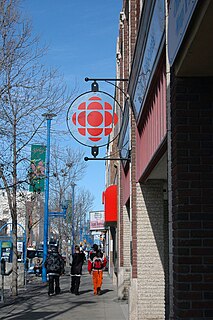
The Hutchinson Building is a landmark building located in downtown Saskatoon, Saskatchewan, Canada. The building was designed by architect Frank P. Martin built to house the Saskatoon Hardware Store Ltd until 1970 then the building was taken over by Saskatoon Handicraft Supplies until 1995. The building was designated a heritage property on August 9, 1999.

The Arrand Block is a historic building located in the Nutana neighborhood of Saskatoon, Saskatchewan, Canada. The building was built by James and Walter T. Arrand, owners of the James and Walter T. Arrand Contractors' Company; Arrand Construction Company intended to use two of the apartments as their homes. Original features of the building include two story apartments, with sky lights on the top floor. The building was designated a heritage property on April 10, 1989.
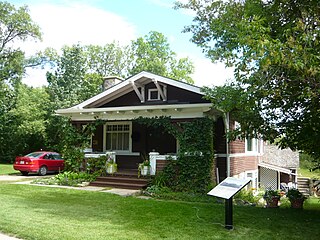
The Bowerman House is a designated Municipal Heritage Property located in the Holiday Park, neighborhood of Saskatoon, Saskatchewan, Canada. The home is of a crafts-man "Western Stick" style. The house was built as a hunting lodge by Allan Bowerman, graduate from Kingston Military College, first postmaster in Saskatoon on the west side of the river, and member of Saskatoon's first town council. Bowerman was also responsible for the development of the Canada Building. The home was designed by Walter William LaChance. Bowerman sold the home in 1917 after the end of a construction boom in the city.
The Landa Residence is a designated Municipal Heritage Property located in the Riversdale, neighborhood of Saskatoon, Saskatchewan, Canada. Thomas E. Heath, Saskatoon's Early Fire Chief lived in the home from 1913–1915. In 1921, the house became the family residence of William and Fanny Landa, the first Jewish family to settle in Saskatoon. William Landa was a carriage maker who immigrated from Russia established the Landa Carriage Works that eventually become the Landa Auto Body Works. The building is of a Pre-World War I Prairie Vernacular architectural style.

The F. P. Martin House is a designated Municipal Heritage Property located in the Nutana, neighborhood of Saskatoon, Saskatchewan, Canada. The house was built by local architect Frank Percy Martin, in a unique Cottage Style with double dormers, Gothic doorways, and lattice windows.

The Albert Community Centre is a designated Municipal Heritage Property located in the Varsity View, neighborhood of Saskatoon, Saskatchewan, Canada. Originally built as the Albert School, the two-and-a-half storey brick building served as a public school until 1978 when the building was sold to the city and became the Albert Community Centre. The school was originally named for Prince Albert, Queen Victoria's Consort. The most noticeable feature of the building include limestone trim, crenellated tower, crossed mullioned windows, dormers and curved parapet gables.

The Adilman Building is a historic building in the Riversdale district of Saskatoon, Saskatchewan, Canada. It is one of Saskatoon's remaining examples of Streamline Moderne architecture.
The Saskatoon Farmers' Market is a non-profit, vendor-owned cooperative that operates year-round, thrice-weekly Farmers' market in a former electrical warehouse and garage in the Riversdale, district of Saskatoon, Saskatchewan, Canada. Featuring more than 100 vendors and resolutely supporting local makers, bakers, gatherers, and growers, the Saskatoon Farmers’ Market is a true farmers’ market.

